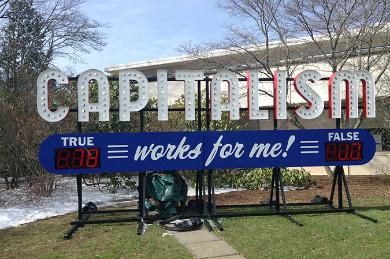
Giana De La Cruz ’24
Specialized Resources


Giana De La Cruz ’24

Margaret Benson ’23

Miya Preyer ’23

Sebastian Arango Chiquillo ’23
Interview with Grace Flautherly ’23

Miya Preyer ’23

Samirah Jaigirdar '22
Reflecting on my work with the Office of Communications

Samirah Jaigirdar '22
Documenting my last Camel Day as a senior

Being a liberal arts college, Conn has hosted numerous exhibitions over the years. Even so, none of them are quite like the sight that greeted students when they returned from spring break.
Created by multimedia artist Steve Lambert and funded through Kickstarter, “Capitalism Works For Me!” is a massive 20-foot-long interactive piece, which encourages passersby to seriously question the effectiveness of a capitalist society. After debuting in Cleveland in the summer of 2011, the piece has toured all around the country, challenging everyone who comes across it to engage in meaningful discussion about a topic that can be considered taboo.
“As a culture, we need the vision and boldness it takes to discuss the problem [capitalism] itself,” Lambert explains on his website. “The idea that 'there is no alternative' to the way our world works takes away our ability to dream. As citizens we need the courage to begin these discussions in order to move on to new and better visions for the future… [and art] creates a space where new ideas and perspectives can be explored.”
The aesthetic of the work is firmly rooted in early-mid 20th century American propaganda and advertising. By drawing comparisons to the large, gaudy signs of yesteryear, Lambert alludes to how capitalism has become ubiquitous with our national identity, while simultaneously questioning the paradox of societal progress. If things like rights for minorities can evolve so drastically over the course of a century or two, why can’t our economic system see similar reforms? More importantly, why aren’t we willing to consider a non-capitalist approach to our economy when recessions and mass layoffs affect millions of people in a negative way?
“For 50 years it has been unacceptable, politically, in the United States to ask what is basically a straightforward question,” Lambert claims. “We have every right as a society to ask of that system [capitalism], is it working for us? Do the benefits and the costs balance themselves out…? We’ve been afraid to ask that question—and we’ve been afraid to have public debates—that’s the legacy of the Cold War. We can’t afford anymore to not do that. We have to raise the question.”
Continue ReadingIt’s 10:30 PM. I’m sitting in a dark room illuminated by a monitor displaying dozens of video clips. Two of my classmates—no, co-producers—sit beside me, scrutinizing the video feed for continuity errors. We’re all exhausted; it’s been hours since we booted up Adobe Premiere. And yet, there’s a palpable sense of excitement that rushes through our veins, pushing us forward.
That’s film studies, in a nutshell.
In many ways, the Film Studies Department is one of Conn’s best-kept secrets. That’s not to say that people don’t know about it—I’ve lost count of the number of people who’ve told me how they’ve always wanted to take a film class at some point in their college career. It’s just that, with so many opportunities and classes to choose from, those desires to take a film class are often abandoned in favor of classes that will fulfill a general education requirement or a degree prerequisite. And that’s a shame; being a part of the Film Studies Department is one of the most unique and memorable experiences I’ve had during my brief time at Conn thus far.
I took Film 101 during my first semester and was pleasantly surprised by the level of intellectual stimulation that it offered. Our goal was to engage with film on a deeper intellectual and critical level. In other words, I found myself taking an English literature course and “reading” complex and challenging films on a weekly basis. This came as a pleasant surprise; English was always my strongest academic subject in high school, so the course was comfortably familiar during my transition to collegiate academics. Actively searching for form, function and meaning within a two-hour work was engaging, and candid class discussions about themes, symbols, visual metaphors and mies-en-scene elements were guaranteed to occur during the following class. As the semester progressed, I knew I had found my niche.
Continue Reading
There’s nothing quite like an impromptu photo shoot to ease your mind, I think to myself as I grab my camera bag and dash across campus.
These sorts of excursions have become relatively commonplace ever since I splurged on a new DSLR camera this past November. Photography—and art in general, I suppose—have always been cathartic outlets for me during good times and bad. This holds true in college: I savor every opportunity to take photos or doodle in the margins of my notes when inspiration strikes, even if it’s slightly inconvenient. After all, when you feel completely overwhelmed by deadlines, assignments, commitments and social drama, sometimes you just need to indulge in a beloved hobby to stay sane.
Continue ReadingIt’s almost Thanksgiving, which can mean only one thing...
No, I’m not talking about decadent turkey dinners or a break from academic pursuits. I'm speaking of the ritualistic procedure of choosing college courses for the coming semester.
In many ways, this process is akin to the Black Friday rush. Hunching over my computer days, even weeks before the servers actually open, I’m compiling spreadsheet after spreadsheet of courses that pique my interest, fulfill a general education area, and/or bring me one step closer to completing the basic requirements for majors I’m eyeing but have yet to declare. I have to formulate and stick to a tight budget of time commitments, factoring in how much homework each class carries and the intensity of the work itself.
By the time I’ve finally come up with a plan of attack, I’m counting down until the scheduling servers open. When they do, I frantically log on to Self-Service, PIN in hand, navigating through cluttered menus and clicking “OK” to whatever prompts stand between myself and my target. Every millisecond counts, especially when it comes to the more popular items—once those 14 or so slots are filled up by peers, they’re gone for good (unless someone drops out, of course). If my timing is impeccable, then I’ll come out of the chaos with a guaranteed slot in every class I wanted; if I’m just a few moments too late, I’ll be lucky just to occupy a high-ranking slot on the waitlist. What fun!
That’s not even considering all the prerequisites one may need to gain access to special offers in the first place. Sending emails to professors I’ve never spoken with and gushing about how much I want to take their class and to please, please, please let me know if there’s anything I could do to improve my chances of getting in is par for the course. So is consulting with upperclassmen advisors who have been through the rigmarole enough times to give you solid advice on what options sound good but are actually a bit of a rip-off, what totally lives up to the hype and the best deals that no one knows about. But even then, no matter how much I’ve prepared and planned, I might not be able to get everything I want.
That’s the way life works, I suppose, but it doesn’t make it easier, does it?
Continue Reading